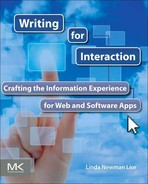Introduction
This book is about designing and creating the content your customers rely on for successfully interacting with your application. This content appears in a variety of forms and formats, serving a variety of purposes—from the labels on each button your customers click on to initiate an action to the step-by-step instructions displayed on the pages of your application.
This book introduces the processes and strategies you need to provide the content to your customers as the “information experience.” As the term content implies, it’s more than a combination of letters and words: Rather, each word, sentence, instruction, and message appearing within the user interface should contribute to the overall understanding and successful interaction between your customers and the technology behind the user interface.
This book describes how you can design, create, and deliver the information experience for your application, and discusses its impact and importance as an integral component of the application and user experience.
Who is This Book For?
When I started writing this book, I assumed the audience would be primarily technical writers and instructional designers who were interested in improving or expanding their skill-set by writing user interface text. As the book progressed, however, I came to understand that as teams struggle to keep up with delivery schedules on minimal headcounts, it’s often the developers, product managers, and user experience designers who are tasked with creating the text within the user interface. As such, this book is for anyone who finds they are writing, editing, or reviewing the user interface text, and all that it entails.
What Will You Learn from Reading This Book?
The impulse to put everything into a book is difficult to suppress. However, there are only so many pages a reader wants in a single book and just so many pages a writer can provide. This book presents the processes, concepts, and guidelines that will help you design, deliver, and create a successful information experience for your customers.
It’s not a book on user experience design, nor is it a book that teaches writing and grammar. This book will teach you the strategies and processes for creating information that bridges the gap between static writing and user experience design, and in so doing, it will provide the information users need for interacting with your application.
How to Read This Book
While you don’t necessarily need to read this book in a specific order—and I doubt you will read it from end to end as you would a novel—it was designed to present the information as a process.
• Section 1 provides an overview of the concept of the information experience and traces its evolultion. The section also describes the impact of the information experience on the overall end-user experience. It also describes how to integrate your processes into the team process and the interaction between the information writer and the rest of the roles making up the team.
• Section 2 describes how to gather data about your customers and how to use the data to understand their information needs. It also explains how to create target personas, and how these personas help keep the end user’s needs at the center of your information strategy.
• Section 3 covers the concepts and strategies you need for designing your content based on how users read and interact with content, and on the information needs of your customers. It also describes how to create the guidelines you will use to produce content that is consistent, clear, and concise.
• Section 4 shows how you develop and create the content based on usability principles and writing guidelines.
• Section 5 describes how to evaluate the information experience created using Section 4, so that you can improve and revise it as needed.
The screen samples provided in this book are designed to show both the positive and less positive examples of user interface text and information, These samples come from a variety of sources found online in Internet applications and in operating systems. I apologize to the writers of any of these pages described as anything less than favorable. Any visuals that were not released to the public are used with permission.
This book is the culmination of my years of studying education and instructional design at San Diego State University and 25 years of my experience working in the realms of instructional designer, technical writer and usability engineer on dozens of applications, and with countless numbers of product managers, project managers, technical writers and editors, developers, testers, user experience designers, graphic artists, and end users, all of whom have taught me something along the way. There are many good books on the market today describing each of these realms. Because the underlying principles behind these disciplines overlap, some sections in this book may be similar to content presented in other books; any such similarities are simply a result of overlapping disciplines, and are not intentional.
